Discover 11 hidden attractions, cool sights, and unusual things to do in Southeast Rügen Biosphere Reserve (Germany). Don't miss out on these must-see attractions: Jagdschloss Granitz, Goor, and Schwarzer See. Also, be sure to include Mönchgut Coastal Fishing Museum in your itinerary.
Below, you can find the list of the most amazing places you should visit in Southeast Rügen Biosphere Reserve (Mecklenburg-West Pomerania).
Table of Contents
Jagdschloss Granitz

Tours of ornate Italianate hunting lodge. Granitz Hunting Lodge is located on the German island of Rügen in the vicinity of the seaside resort of Binz. With over 200,000 visitors per year it is the most popular castle or schloss in Mecklenburg-Vorpommern.[1]
Address: Pf 1101, 18609 Ostseebad Binz
Goor

Nature reserve in Putbus, Germany. The Goor is a woodland, seven hectares in area, on the German Baltic Sea island of Rügen near Lauterbach, a village in the borough of Putbus, which runs for about 1.5 km directly along the shore of the Bay of Greifswald. The woods of the Goor consist predominantly of beech and English oak. They are designated as a nature reserve and are popular with walkers.[2]
Address: Lauterbach, 18581 Putbus, Southeast Rügen Biosphere Reserve
Schwarzer See
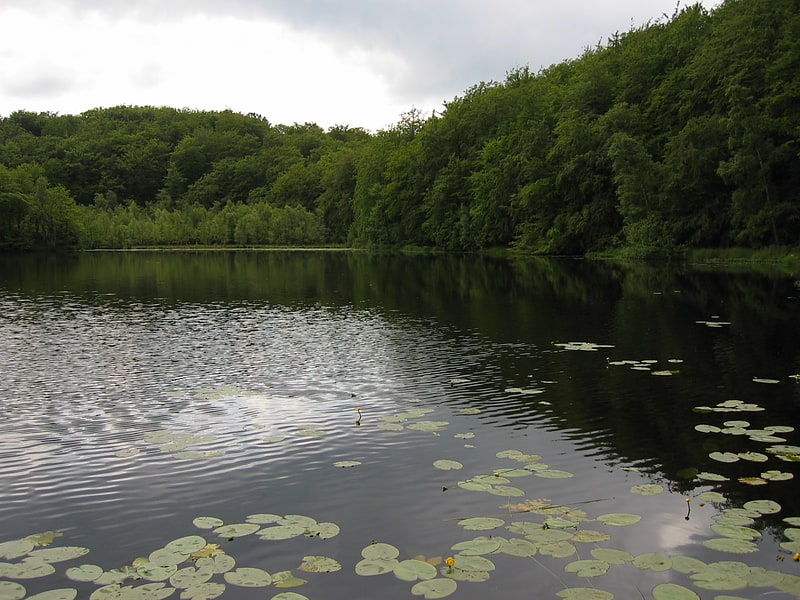
Lake in Germany. The Schwarzer See is a lake on the German Baltic Sea island of Rügen. It belongs to the municipality of Sellin and is located in the Granitz Forest.
The lake has an area of 23 hectares, a greatest depth of 15 metres and the elevation of its water surface above sea level is 54.2 m above sea level (NHN). The lake, which is poor in nutrients, is one of the very rare types of waterbody, a so-called kettle lake (Kesselsee).
Around the shores the formation of transitional bogs and raised bogs is taking place. It places there is a quagmire vegetation. Here, peat moss, cottongrasses, bog-bean, cranberries and bog rosemary occur.
The entire lake, the bogs around its shores and a 100-metre-wide strip of the wood surrounding the lake are designated as a core zone of the Southeast Rügen Biosphere Reserve. That said, the lake is accessible to hikers and cyclists along the path from Binz to Sellin. The lake itself can be reached on a small wooden jetty.[3]
Mönchgut Coastal Fishing Museum
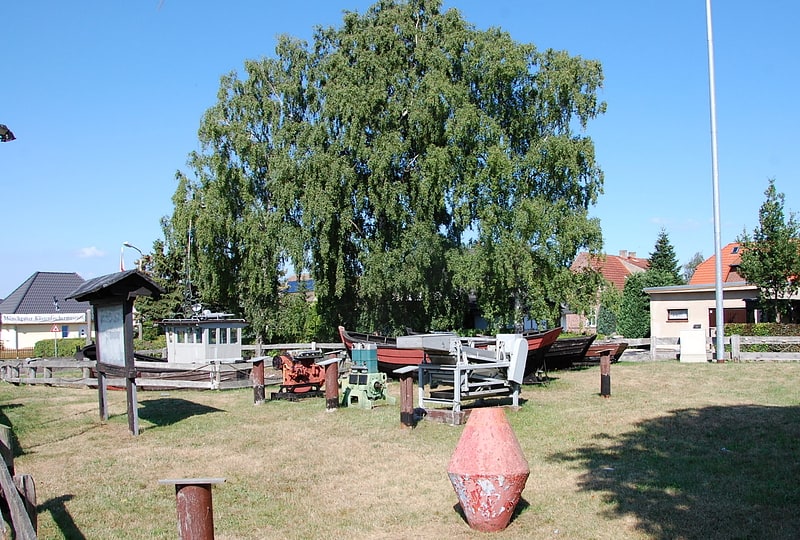
Also known as: Mönchguter Küstenfischermuseum
The Mönchgut Coastal Fishing Museum in the German Baltic Sea resort of Baabe shows the methods of production used by fishermen living on Mönchgut, who were influential boat builders. The museum opened on 2 June 2001.
The exhibits include, among others, the 9.20 m long motorboat Ossi. The parish of Baabe acquired it after it was decommissioned, along with many other fishing boats built in Baabe. In addition, the museum displays so-called Motorreusenboote - motor boats with bow nets, including the Polk (an Anlandungsboot) complete with its original traps. The exhibition also includes a herring sorting machine, information boards about fishing and boat building as well as personalities of the local fishery.
The museum is open all-year round.[4]
Lancken-Granitz dolmens

Also known as: Großsteingräber bei Lancken-Granitz
The Lancken-Granitz dolmens are a group of seven megalith tombs in the Lancken-Granitz municipality on Rügen, northern Germany. Erected during the middle Neolithic, when they were used by the Funnelbeaker culture, at least some were in use until the early Bronze Age. Three of them are encircled by solitary rocks forming either rectangles or a stone circle, one has a solitary "guardian stone" on its eastern side.
The dolmens were constructed from glacial erratic boulders and red sandstone. In part subdivided into up to four compartments as common for the region, one dolmen showed a subdivision into six such compartments, which is an unusually high number. When the tombs were archaeologically assessed in 1969, Stone and Bronze Age funerary goods were retrieved, including flint hatches, stone axes, amber pearls, bronze needles and necklaces as well as an abundance of arrowheads and pottery.[5]
Prussia Columns

Also known as: Preußensäulen
Historical landmark in Putbus, Germany. The Prussia Columns are two monuments, over 15 metres high, that were erected in the years 1854 and 1855 by order of the Prussian king, Frederick William IV on the southeast coast of the German island of Rügen near Neukamp and Groß Stresow. Both villages are today part of the municipality of Putbus.
The monument near Neukamp was inaugurated on 15 October 1854 and the one near Groß Stresow exactly one year later, on the 60th birthday of Frederick William IV. The drums and parts of the pedestal were carved from one of the largest glacial erratics on and around Rügen, the Great Rock near Nardevitz on Rügen's Jasmund peninsula. Most of the rock was destroyed as a result of being quarried for the columns. Nevertheless, it is still impressive today, and sticks 3 metres out of the ground.
The monuments were intended to commemorate the landings of the Brandenburg and later, Prussian troops on the island in the years 1678 and 1715 and to demonstrate Prussia's claim to power over the southern Baltic Sea region. The island of Rügen, which had belonged to Swedish Pomerania since the Treaty of Westphalia in 1648, was on each occasion briefly wrested from Swedish rule as a result of the invasions, but then returned to Sweden as a result of subsequent peace agreements.[6]
Granitz
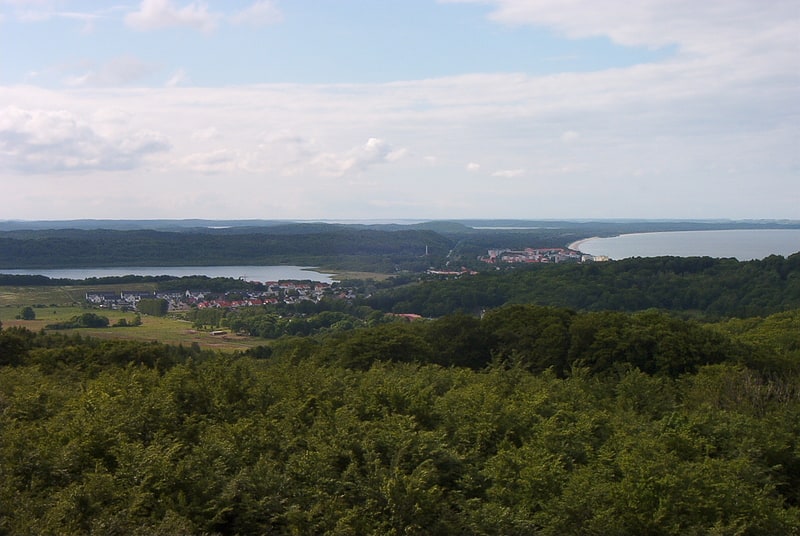
The Granitz is a wooded ridge in the southeast of Germany's largest island, Rügen, between the Baltic Sea resorts of Binz and Sellin. The woods cover an area of 982 hectares and are designated as a nature reserve. Since 1991 they have been part of the Southeast Rügen Biosphere Reserve.
Characteristic of the Granitz are its rich stands of beech and sessile oak and its rolling landscape of push end moraines, which in some ways resemble a mountain landscape. To the north and east the Granitz is bounded by a cliffed coast on the Baltic Sea. In the south it adjoins the Mönchgut region and in the north, the narrow bar of the Schmale Heide. The 23-acre (9.3 ha) Black Lake (Schwarzer See) lies in the Granitz as do several kettle bogs. A number of non-native stands of conifers are being turned into a near-natural forest.
No roads of any description run through the Granitz, but there are many cycle and footpaths. Local transport and access to the area is provided by the Rügen Light Railway and Binz Seaside Railway (Binzer Bäderbahn).
On the highest point, the Tempelberg (107 m above sea level (NN)), Prince Wilhelm Malte I of Putbus had the Granitz hunting lodge constructed in the 19th century. Other landmarks include Granitz House, the grave site of Finnish warriors and the Cross Oak (Kreuzeiche).
The name is probably of Slavic origin and comes from the personal name, Granza, used by the Rani tribe, which first appears as a prince's name in the Saxo Grammaticus in 1168. In 1888, the Waldhalle, a tourist restaurant, was built on the hill of Falkenberg on the clifftop path from Binz to Sellin near the coast. The building had to be abandoned and demolished in the 1980s as a result of coast collapse. Only a few remains of foundations on the cliff face of the Baltic Sea coast recall the existence of the building.[7]
Wreechener See Nature Reserve

Also known as: Naturschutzgebiet Wreechener See
Nature preserve in Germany. The Wreechener See Nature Reserve is a nature reserve in the German state of Mecklenburg-Vorpommern. It lies 2 kilometres south of the town of Putbus and has an area of 72 hectares. It was placed under protection on 12 September 1990 as part of the creation of the Southeast Rügen Biosphere Reserve. The purpose of its designation as a nature reserve is to preserve a lagoon-like cove in the Bay of Greifswald as one of the last regional quiet areas for resting water birds. The Wreechener See also has areas undergoing natural silting up that support special communities and are breeding grounds for rare bird species. Adjacent wet meadows are extensively used.
Nearby villages are Wreechen, immediately to the east, Krakvitz and Neukamp. The cove is linked to the Bay of Greifswald by a short narrow channel spanned by a wooden road bridge.
The condition of the reserve is only classed as satisfactory, because the water condition is affected by discharges of agricultural fertiliser. In 1997, there was mass fish mortality due to the lack of oxygen in the water of this hypertrophic lake. The macrophyte flora almost entirely disappeared, but has recolonised the lake in several areas. Reed continues to be harvested for thatch within the reserve.
In the north of the reserve there is a refuge hut with a good view of the lake and the Baltic Sea beyond. The road from Neukamp to Wreechen runs immediately along the eastern border of the reserve.
According to EU law, the area is a Special Area of Conservation as well as a Special Protection Area for birds.[8]
Selliner See
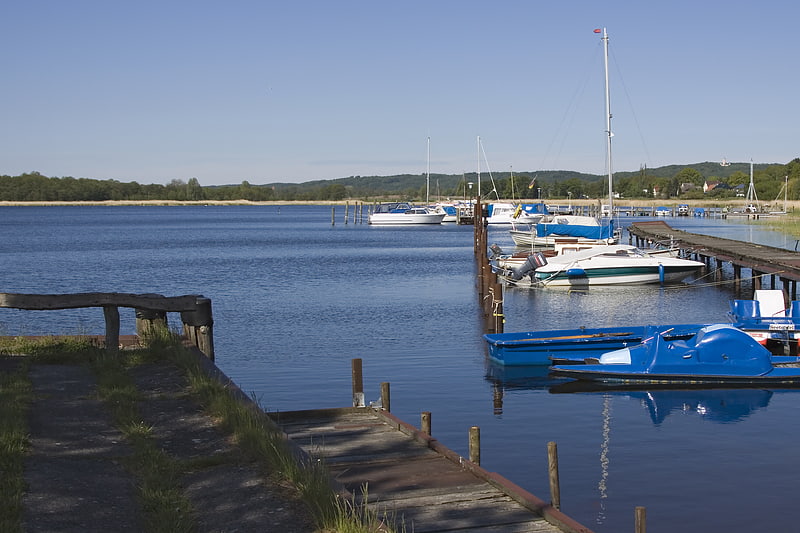
Lake in Germany. Selliner See is a lake in the Vorpommern-Rügen district in Mecklenburg-Vorpommern, Germany. At an elevation of 0 m, its surface area is 1.38 square kilometres[9]
Museum of Education
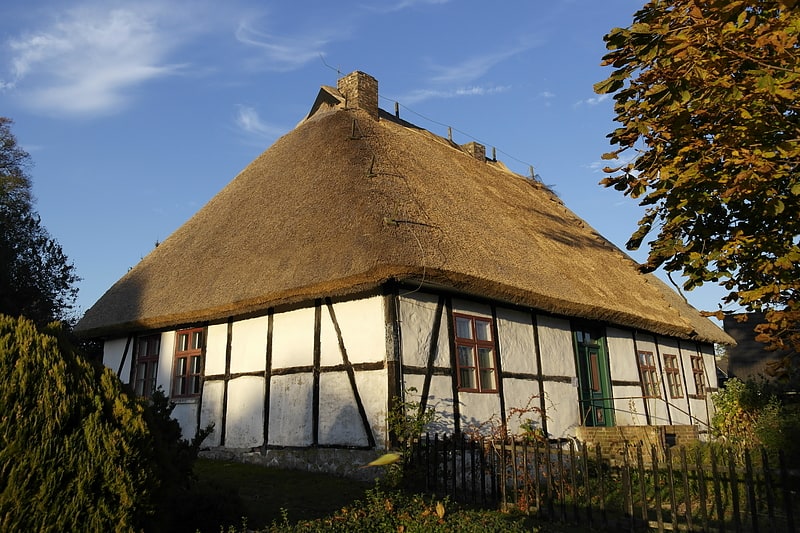
Also known as: Schulmuseum
The Middelhagen School Museum is a museum dedicated to the history of educational development on Mönchgut, a peninsula on the island of Rügen, in Middelhagen. It is located in the center of the village next to St. Catherine's Church and opposite the old jug. It was opened on August 1, 1986 in the former sexton's house.
In 1747, the predecessor building of today's sexton's house was first mentioned in a file note. It was a chimney-less smoke house, typical of the local farm and fishermen's houses of the time. Around 1825, the building that has been preserved until today was erected. The priest from Middelhagen also used this house for his official duties until the parsonage was built in the village itself.
In the museum you can see a classroom of a one-class school, where up to 60 children (still in 1946) were taught from the 1st to the 8th grade. Children from 6 to 14 years old were thus accommodated in a single room. Still at the end of the 19th century, the subject matter was thus primarily limited to writing, arithmetic and reading (mostly of the catechism and hymnal) as well as religion.
Until 1962, this sexton's house housed the one-class feeder school - at that time, however, already limited to grades 1 to 4 - for the Mönchgut Central School, which had been built in the meantime and was located on the road to Gager.
In the classroom you can see wall scrolls, learning to read boards, the calculating machine "abacus" and taxidermied animals as teaching aids of that time.
In addition to the schoolroom, it was also common that the apartment of the sexton, cantor and village schoolteacher with living room, bedroom, office, study and kitchen were located there at the same time. It can still be seen in the museum.
Address: Dorfstrasse 4, 18586 Middelhagen
Sankt Andreas
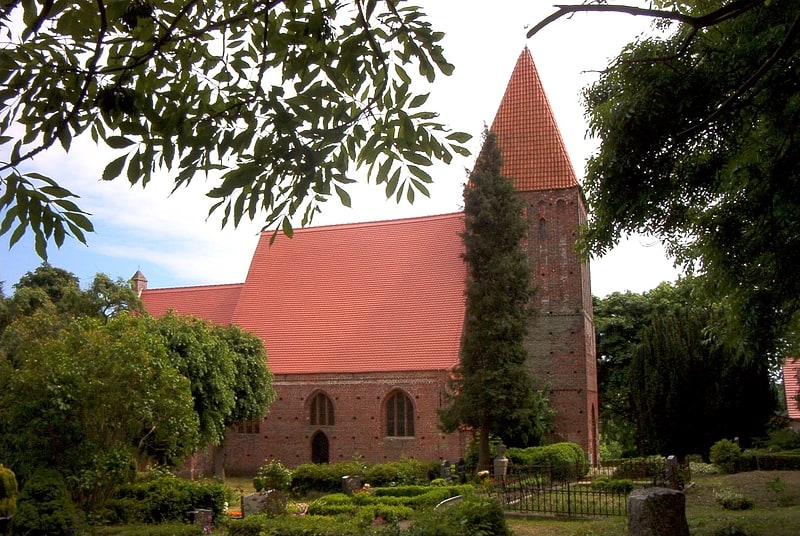
Saint Andrew's Church is the Lutheran church of the village of Lancken-Granitz on the Baltic Sea island of Rügen.